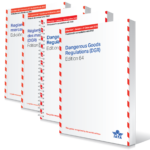Shipping Aerosols by Air
At some point in our lives, chances are we have come across many different types of aerosol products. Aerosols can come in the form of spray paints, hair sprays, room deodorizers, shaving cream, deodorants, and many other products. What you may not know is that aerosols are considered dangerous goods. Often times aerosols go by the UN Number 1950, but there can be many possible proper shipping names. It is important to pinpoint the type of aerosol that you are shipping, especially if you are shipping by air, in order to determine if you are allowed to ship a desired quantity or if you plan on shipping using the limited quantity exemption.
What type of Aerosol am I shipping?
This can be found in the SDS, specifically section 14. There are many different possibilities here, it may be listed as Aerosols, Flammable for example, which is a class 2.1, or it can be a multitude of other possibilities including Aerosols, Flammable containing substances in class 8, packing group II, as another example. The dangerous goods list in IATA located in section 4.2 (known as the blue pages) has a whole bunch of proper shipping names listed, all under UN1950. If you don’t have the SDS for your aerosol, you should definitely obtain it from the manufacturer before shipping it.
Why is it Important?
When you are shipping by air, certain aerosols are forbidden per IATA. For example, when you go to the blue pages in IATA and look up Aerosols, flammable, containing toxic gas class 2.3 (2.1), you will notice it says “forbidden” across columns G through L. This would mean you are not allowed to ship this particular type of aerosol by air. There are several similar examples of UN1950 aerosols where you will see the same thing. On the other hand, if you are shipping Aerosols, non-flammable class 2.2, you are allowed to ship these by passenger, cargo, or as limited quantities.
This is why it is important to know exactly what type of aerosols you are shipping. There may also be different special provisions for certain entries and some you are allowed to ship as limited quantities per columns G and H and others you can’t ship as limited quantities. If you are allowed to ship your aerosol by air, the regulations will send you to packing instruction 203. This is where it will tell you the allowable limits for both passenger and cargo as well as the inner packaging limits.
The capacity of metal receptacles is not allowed to exceed 1000ML while plastic receptacles cannot exceed 500ML. An outer packaging meeting at least a PG II (Y) performance standard must be used as well. In terms of labeling, it really depends on the proper shipping name the aerosol was assigned to in the SDS. It may require a class 2.1 or 2.2 label and possibly a subsidiary hazard label as well. This also shows why it is important to have the SDS for the aerosol to help you make that determination.
If you have questions about Shipping Aerosols, and the products and training your team needs to have to do so safely, Contact us today. We can help you choose the products and courses you need!
Stay up to date and sign up for our newsletter!
We have all the products, services and training you need to ensure your staff is properly trained and informed.










 ICC USA
ICC USA ICC Canada
ICC Canada